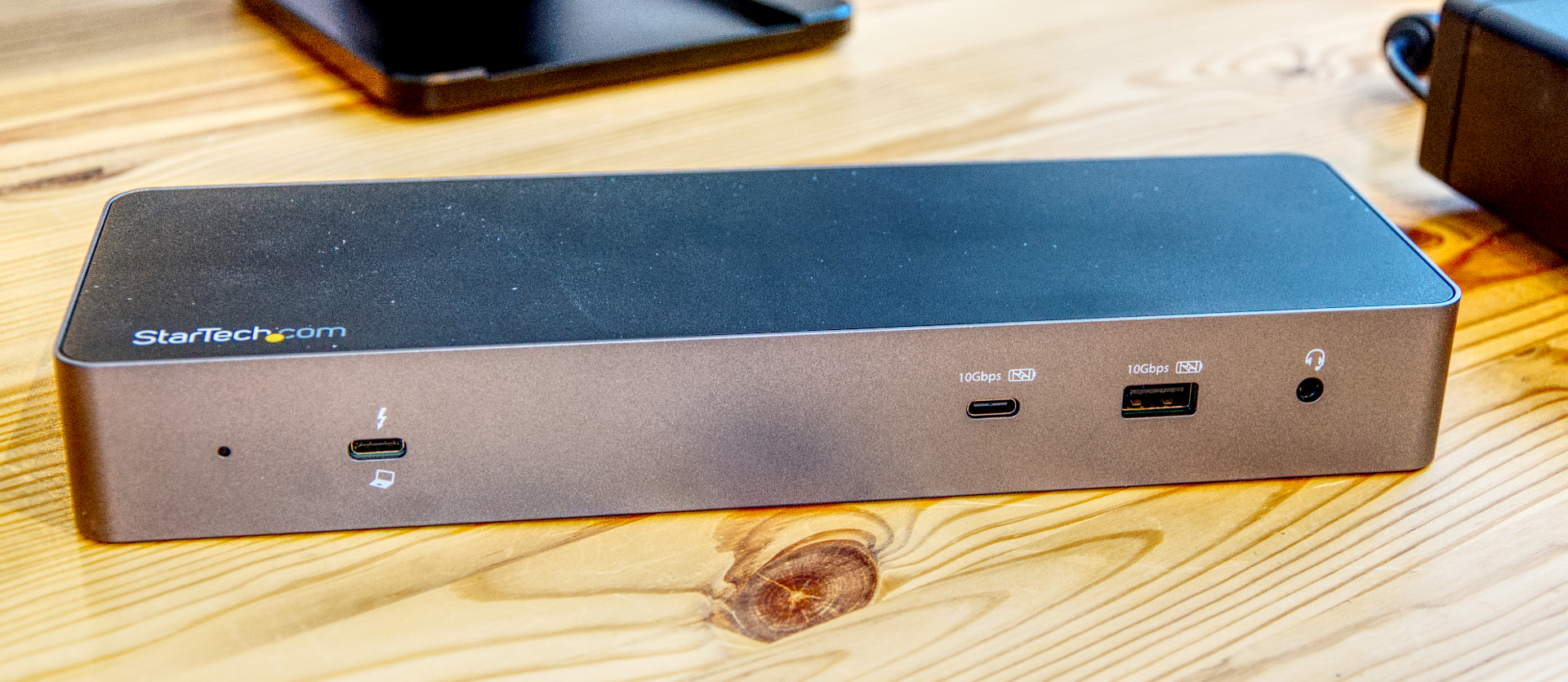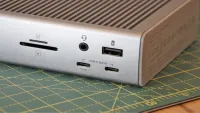TechRadar Verdict
While not supporting Thunderbolt 4 isn’t a huge deal, having no downstream Thunderbolt port certainly is. But its other weaknesses, basic plastic construction and redundant ports undermine the relatively lower cost of ownership.
Pros
- +
Dual HDMI and DisplayPort
- +
Twelve ports, sort of
- +
Five USB 3.2 ports
Cons
- -
No TB downstream port
- -
Plastic construction
Why you can trust TechRadar
StarTech Thunderbolt 3 Dock: 30-second review
StarTech has been a firm supporter of Thunderbolt products from this technology's inception. Therefore, that they made a Thunderbolt 3 docking station shouldn’t be a huge surprise.
The TB3CDK2DH, as this dock is identified, is a combined Thunderbolt 3 and USB docking station with 12 ports (including the host uplink). It is rated to charge a Thunderbolt or USB-connected laptop with up to 96W and uses Intel Titan Ridge silicon alongside C-Media, Genesys Logic, Realtek and Cypress chips.
In the box is the PSU, appropriate power cable, user manual and a 80cm Thunderbolt 3 USB-C cable.
Measuring some 25cm long, this is a fairly substantial dock that isn’t made for portability, especially when coupled with its gargantuan PSU block.
The port selection is somewhat mercurial with dual DisplayPort and HDMI, although you can only use two of the four. There are plenty of USB ports with no less than five USB 3.2 Gen 2 ports, but only one Thunderbolt downlink and a gigabit LAN port.
What’s missing here is an SD card slot, but it does have a Kensington security slot, a feature missed by some docks.
More of an issue here is the asking price of $287.99 for a dock that is primarily plastic, isn’t Thunderbolt 4 specification, and only has a single Thunderbolt downlink port. It can be found significantly cheaper online, but so can higher specification docks that don’t have the same limitations.
Sign up to the TechRadar Pro newsletter to get all the top news, opinion, features and guidance your business needs to succeed!
StarTech Thunderbolt 3 Dock: Price and availability
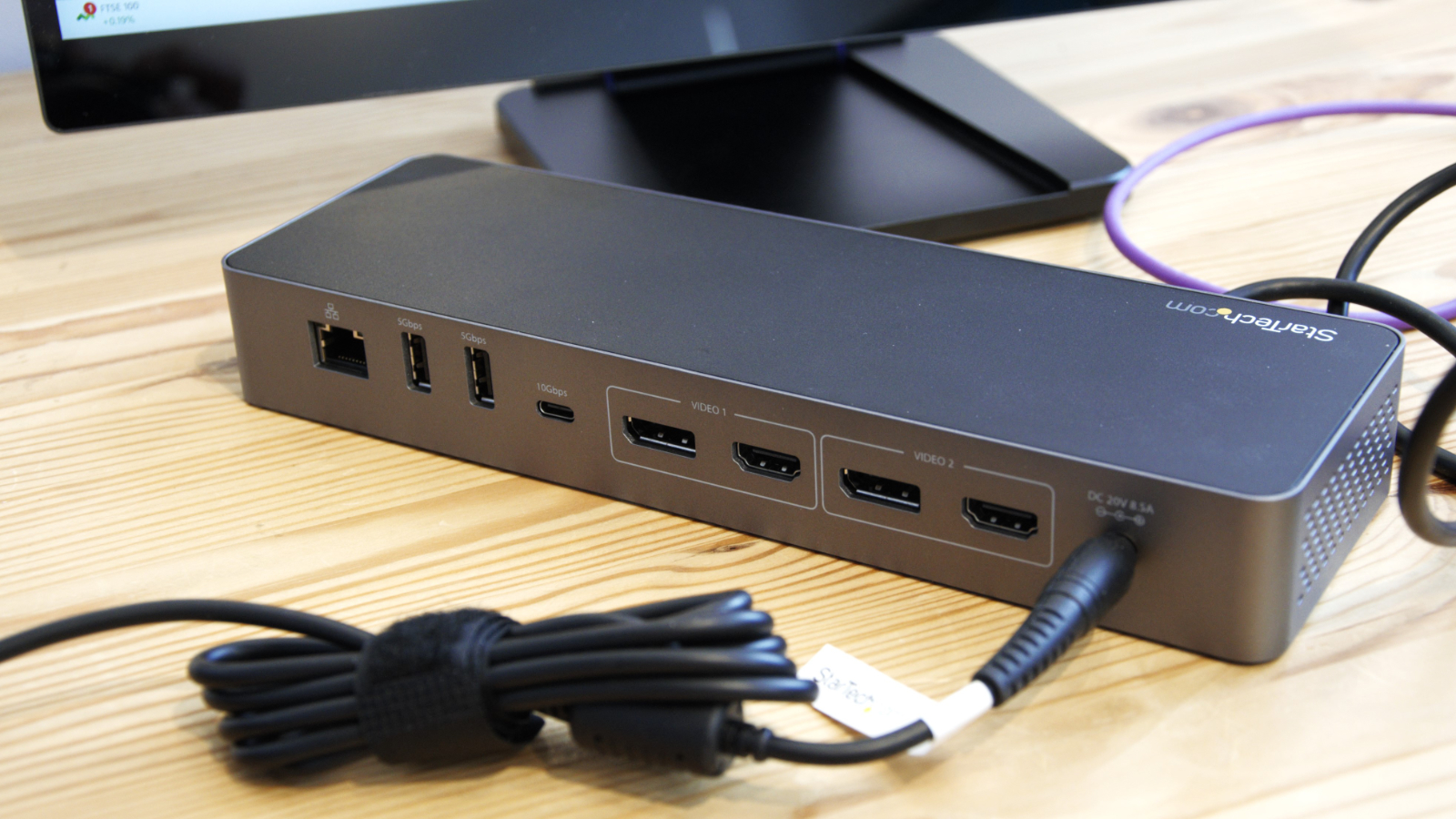
- How much does it cost? $288/£293/€ 338
- When is it out? It is starting to be available now
- Where can you get it? Direct from StarTech or through online retailers like Amazon.
For a fully featured Thunderbolt dock, the StarTech Thunderbolt 3 Dock price at $287.99 is in the ballpark of what other vendors are asking.
For a better deal, go to the bigger online retailers. It can be found on Amazon.com for only $244.41 and Amazon.co.uk for £204.99, definitely savings worth having.
Why a considerable discrepancy exists between the direct cost and the online retailers is hard to rationalise.
- Value: 3.5 / 5
StarTech Thunderbolt 3 Dock: Specs
| Compatibility | TB3, USB-C |
| Number of Ports | 12 |
| Ports | 1x TB4 upstream, 1x USB 3.2 Gen 2 Type-A, 2x USB 3.2 Gen 2 Type-C, 2x USB 3.2 Gen 1 Type-A, 2x HDMI, 2x DisplayPort, 1x universal audio combo jack, 1x 1GbE RJ45 Ethernet port |
| Downstream power | 15W or 7.5W on USB |
| Upstream power | 96W Thunderbolt |
| Size | 250 x 80 x 33 mm (W x D x H) |
| Weight | ?0.7 Kg |
| Accessories | Adapter 170W 20V 8.5A |
StarTech Thunderbolt 3 Dock: Design
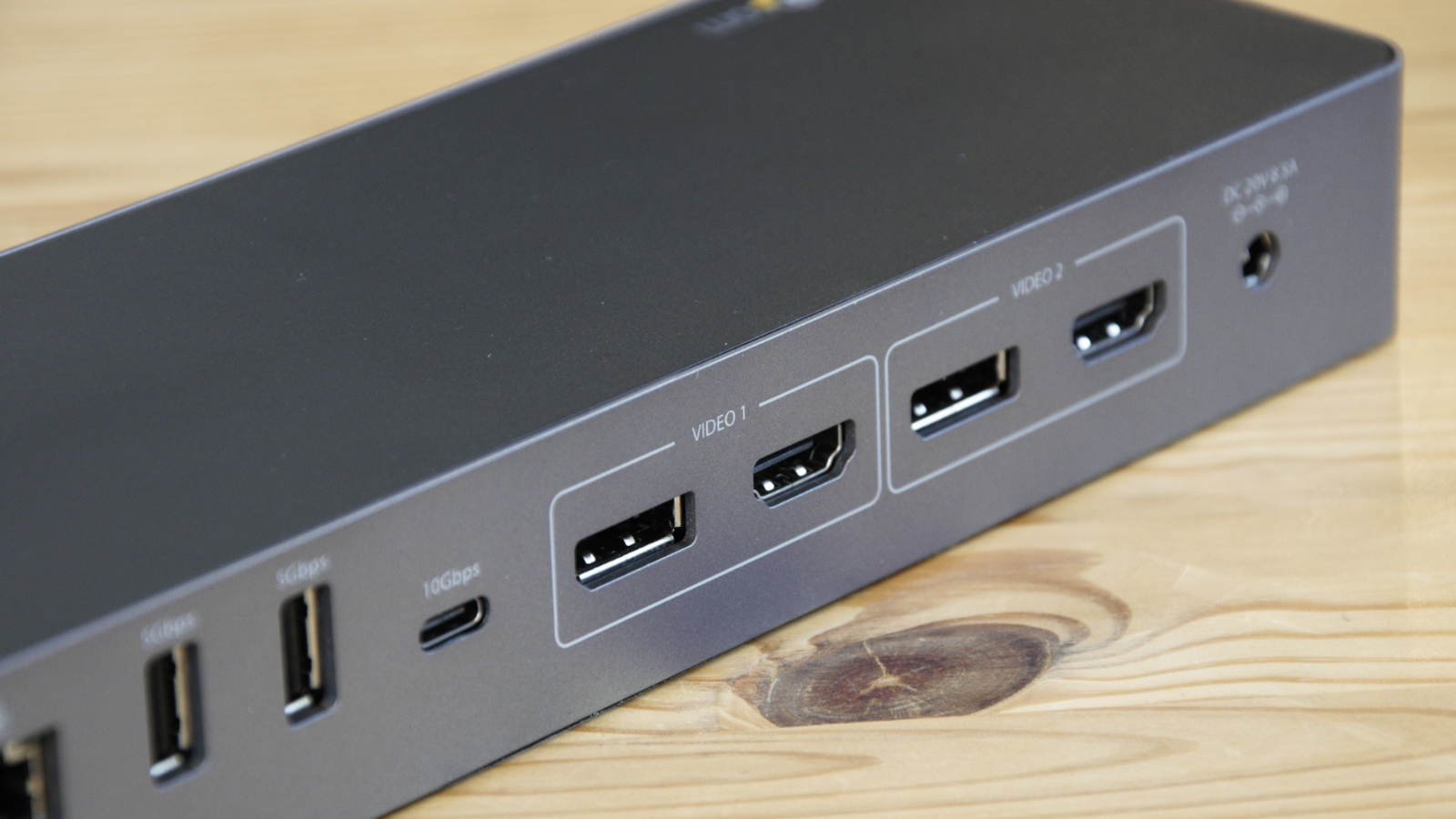
- Entirely plastic
- Limited ventilation
- Mounting options
Often, StarTech hardware has a distinctly functional look rather than anything made to be attractive. The StarTech Thunderbolt 3 Dock is no exception, being a two-tone gunmetal and black box with chamfered corners.
What’s mildly off-putting is that while other dock purveyors typically use an aluminium tube as the critical structural component, StarTech made this entirely of plastic. This feels less substantial and is obviously much less resilient than anything made of metal.
In terms of the layout, there is little radical to see here. The uplink port, a couple of USB outlets and the audio jack are on the front, while all the other ports are on the back.
The right side has a Kensington slot for those who like to secure hardware in a workplace, and both ends have small slotted vents for air to circulate in and out. There is no active cooling from what we can determine, and as the plastic case won’t act as a radiator, the small size of these vents hints that StarTech doesn’t consider overheating to be an issue.

One curious external feature we’ve never seen before is on the underside, a 40cm square pattern with four mounting points. The StarTech documentation describes this as a means to mount the dock to a monitor or surface, and in the available accessories is a steel mounting plate for attaching it to any solid surface.
I guess that avoids accidentally knocking the dock off the desk, but better rubber feet might have had the same results.
It should also be noted that there is no power button. The dock is on once it is connected to the PSU if that is attached to the mains. It's not ideal, but StarTech isn’t the only maker that does this.
Overall, the StarTech Thunderbolt 3 Dock doesn’t have the industrial construction we’ve seen from many dock makers.
- Design: 3.5 / 5
StarTech Thunderbolt 3 Dock: Features
- 12 ports
- No TB downlink
- 96W charging power
Without a doubt, the best aspect of this dock is that it will charge a connected laptop with 96W, more than cheaper hubs and docks are offering.
When does a 12-port dock not have that many ports? If you count the ports on this hardware, you will undoubtedly find twelve unless you insist on including the power connection.
For starters, every dock maker includes the host link as a port when the dock can do relatively little without this connection.
But on this design, there are four video ports, two each of HDMI and DisplayPort, and you can’t use all four at once, reducing the eleven down to nine useable ports.
That would be fine if those nine were the ports you need or want, but as with many things in this product, compromises have been made.
While the dock supports Thunderbolt 3 and USB-C connections, the focus is very much on USB. While the dock can connect a Thunderbolt 3 port to the system and take 96W charging from that line while sending up to 40Gbps of data to and from the dock, there are no TB downlinks. One would be nice, but none means that you can’t connect Thunderbolt peripherals to the dock, including monitors that use that technology.
Without Thunderbolt downstream, the transfer bandwidth has been divided between the five USB ports of various specs and port types, the LAN port and the display outputs.
The two USB ports on the front, one each of Type-A and Type-C, can be used for charging phones since they can provide 7.5 and 15W power to connected devices. Both these are also Gen 2 (10Gbps), making them ideal for attaching storage.
On the rear are another three USB ports, with two USB-A Gen 1 (5Gbps) and one USB-C Gen 2 (10Gbps). If you add the potential bandwidth of all the ports, it uses up all of the 40Gbps that Thunderbolt offers—not taking into account the bandwidth required for the monitors and LAN.
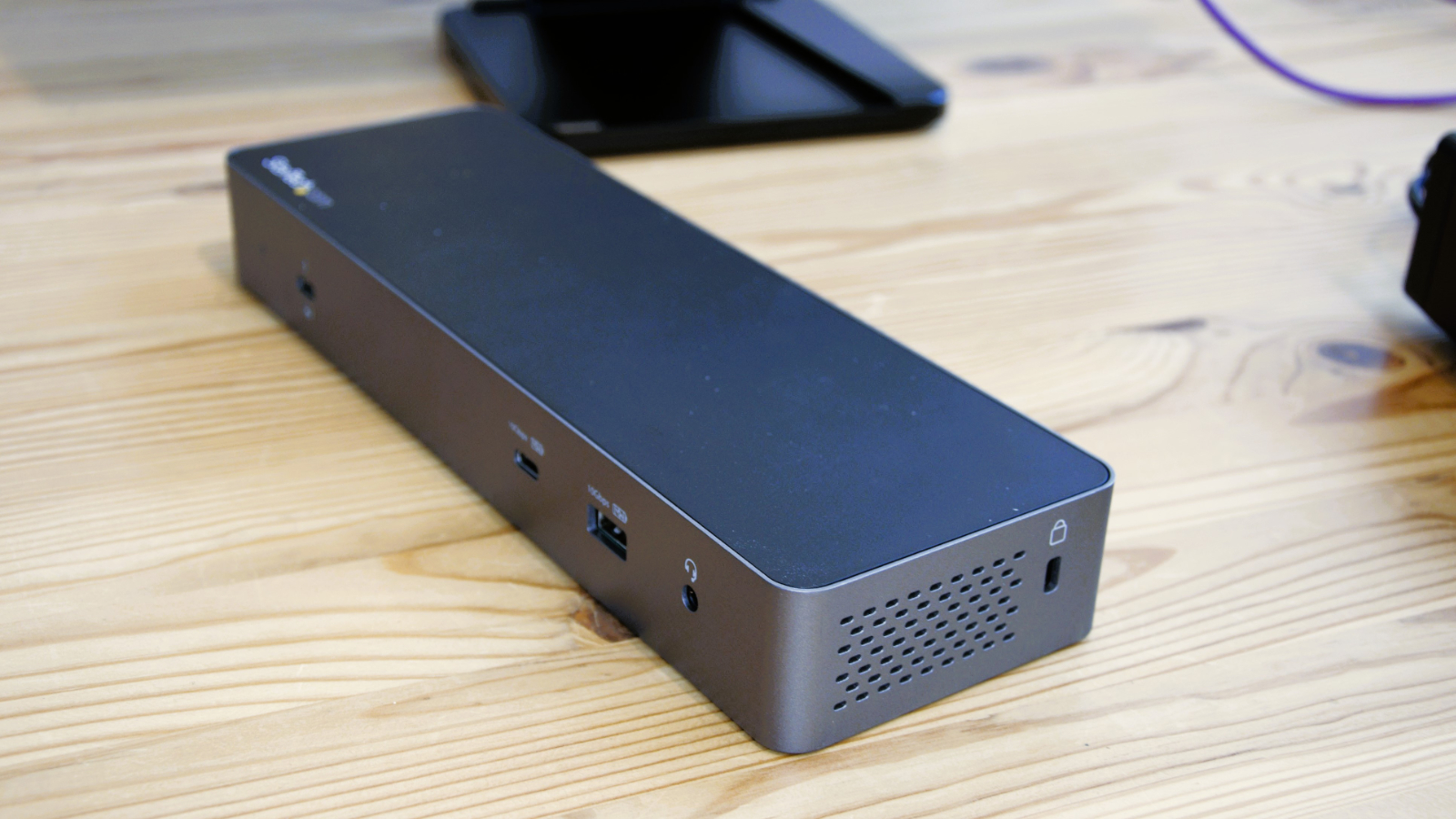
This type of oversubscription is typical in docks and assumes that you wouldn’t use every port to its full potential, in the way that airlines overbook flights and presume that not everyone really wants to fly today.
If you use the display outputs, then a large chunk of bandwidth is allocated for those, and there are some other limitations on how they can be used depending on the computer you connect to.
This review will not get into the weeds about Apple Mac M1 and M2 machines, as these issues are covered in more depth on the StarTech website. But importantly, some M1 and M2 MacBooks don’t support dual monitors other than to mirror the one output. They also only support a maximum resolution of 5K, whereas on a PC laptop, it is possible to get 8K over a Thunderbolt connection.
If you use USB-C and not Thunderbolt, you are limited to 4K on a single screen, and depending on which Alt-mode the port supports (DP 1.2 or DP 1.4), you might only get 1080p from dual monitors.
As StarTech left out the Thunderbolt downstream port, you can’t get a third display by putting an adapter on that.
- Features: 3 / 5
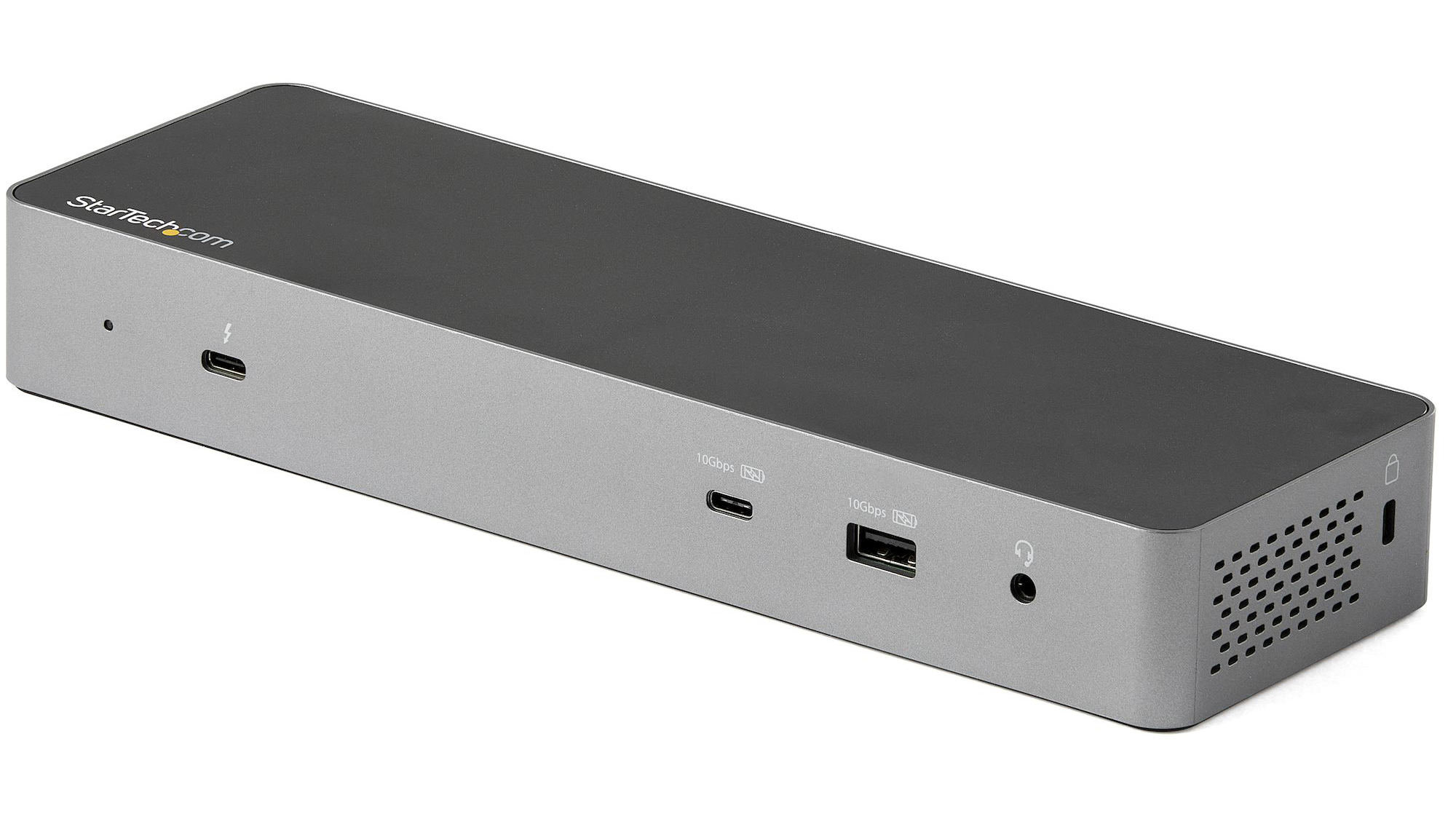
StarTech Thunderbolt 3 Dock: Verdict
This might be considered a bargain if bought online, but the devil in this detail is the lack of a downstream Thunderbolt port. That makes this dock much less attractive, even if it can offer 96W of charging to the connected host.
The USB options are good, but the LAN port is only gigabit, not 2.5GbE, and having four display outputs when you can only use two isn’t that helpful.
Those wanting an inexpensive dock for some basic connections might be happy with this solution, But for another $50, you can get something much more flexible that is better able to adapt to changing scenarios.
StarTech Thunderbolt 3 Dock: Report card
| Value | Online pricing is competitive and much cheaper than direct pricing. | 3.5 / 5 |
| Design | AAll plastic construction, logical port layout and mounting options | 3.5 / 5 |
| Features | No TB downstream port is disappointing. | 3 / 5 |
| Total | Affordable, but some of the limitations on this dock make it far from ideal for those who use Thunderbolt. | 3.5 / 5 |
Should you buy a StarTech Thunderbolt 3 Dock?
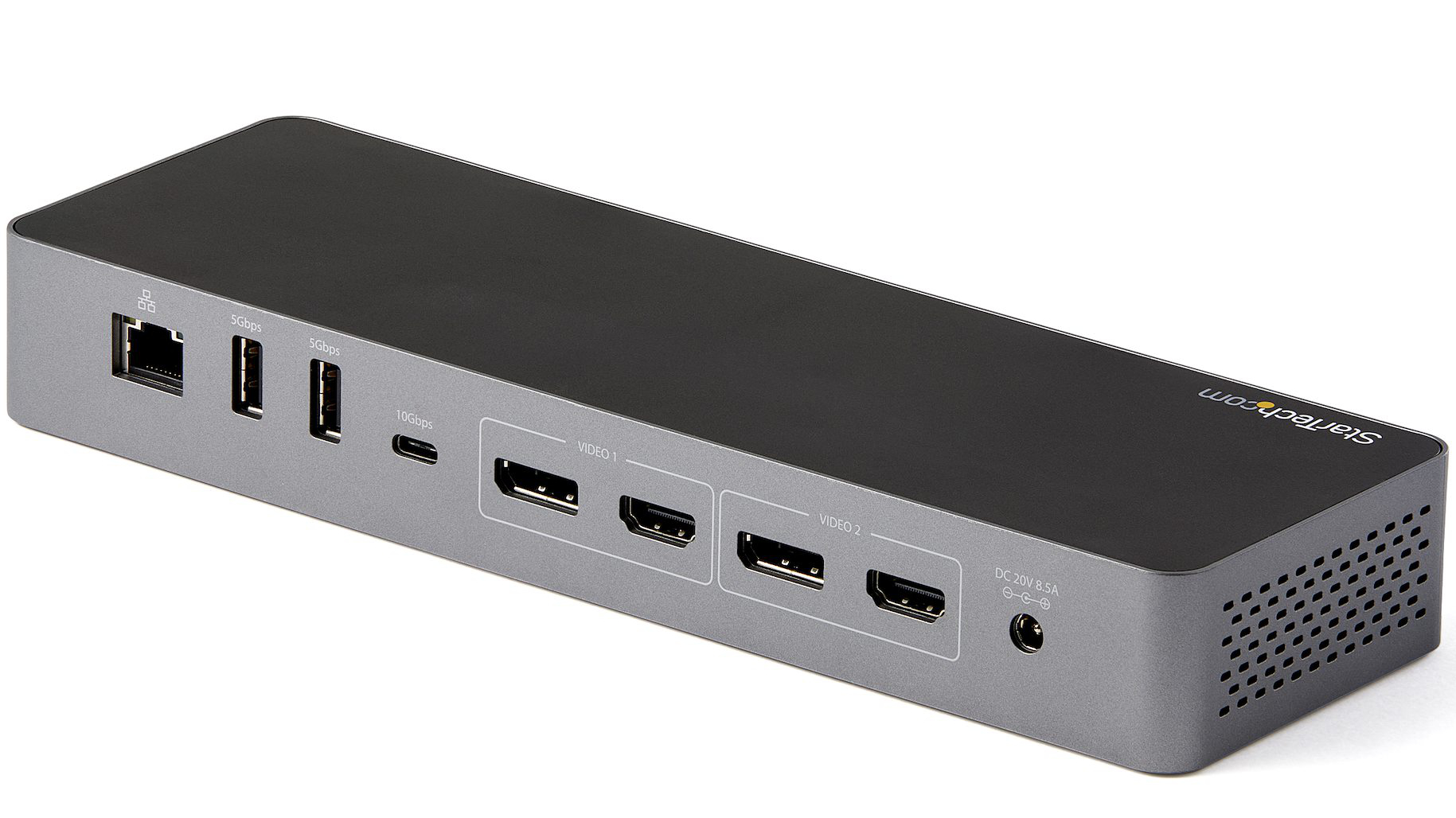
Buy it if...
You need a basic dock
Especially for European customers, this is an inexpensive dock that will work for those who have a Thunderbolt port on their laptop but mostly use USB peripherals. It’s not the best made or featured, but it is cheap.
Security is important
The inclusion of a K-slot allows this dock to be securely connected to its workplace, and not every dock has this option.
Don't buy it if...
You use Thunderbolt peripherals
Without a Thunderbolt downstream port, you can’t chain other Thunderbolt devices or use display adapters that utilise that technology. This feature omission effectively reduces this to being a USB-C dock.
You have an older MacBook M1
It's not a StarTech issue but an Apple one. These docks don’t work well with the original Apple MacBook M1 machines that use USB-C and not Thunderbolt. If you are unsure what MacBook you have, StarTech has some information about what the limitations are for various machines.
Also consider
OWC Thunderbolt Dock
A cheap but still high-quality dock from OWC, this design has eleven ports with 90W charging and three TB downlinks.
What it lacks is a dedicated monitor port, but adapters for HDMI or Display port from Thunderbolt are available.
Check out our OWC Thunderbolt Dock review
CalDigit Thunderbolt Station 4
The CalDigit Thunderbolt Station 4, or TS4 as it is also known, is a full-featured Thunderbolt dock that works with Thunderbolt 4/3 and USB-C.
It is not designed to be a portable dock but specifically to support a laptop user who comes to the office and wants a single cable connection to the network and a host of peripherals. To that objective, it has no less than 18 ports and can deliver up to 98W for charging a connected system.
Check out our CalDigit Thunderbolt Station 4 (TS4) review
Mark is an expert on 3D printers, drones and phones. He also covers storage, including SSDs, NAS drives and portable hard drives. He started writing in 1986 and has contributed to MicroMart, PC Format, 3D World, among others.
